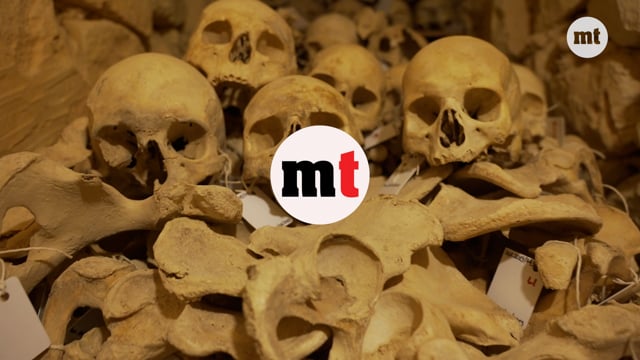[WATCH] Carbon dating unravels mystery of Żejtun’s secret skeleton trove
New studies shed light on mystery skeletons discovered inside Żejtun church in 1969, and create new avenues for historical inquiry


A new study on the human bones found inside Żejtun’s St Gregory’s Church has helped unravel the mysteries surrounding the remains and offered an insight into the domestic life of Malta’s noble families.
The study comes over 50 years after the skeletal remains were discovered at the church, with NGO Wirt iż-Żejtun celebrating the anniversary by shedding light on the real story behind these remains using the modern technology afforded to archaeologists today.
Carbon dating found that the oldest skeleton found inside the chruch dates back to the late 15th century, while the more recent remains date back to 19th century.
And five of the 35 skulls found at the church did not belong to Maltese people. Indeed, the skulls belong to five women from Sub-Saharan Africa who were likely “slaves” or servants belonging to Maltese noble families. This was corroborated by the parish archives, which show that many African slaves had been baptised and integrated into Maltese society.
Isotope testing further helped researchers identify what sort of diets these people lived on.
From the sample taken it seemed that six people shared a common diet, while one person appeared to eat a more vegetarian diet without fish or meat – namely, one of the five slaves identified during the study.
But this is not the first study of its kind. Wirt iż-Żejtun president Ruben Abela told MaltaToday that another study was carried out by two university academics in the late 1970s, where they determined the exact number of skeletons present, and whether they were adults or children. Some soil found on the remains suggests the skeletons had been buried elsewhere and later placed in the church.
“But this story in itself was always refuted. The staircase leading up the church passageway, as well as the passageway itself, is incredibly narrow – why would someone go through the trouble of transferring the remains to this high area, as opposed to placing the remains in a common burial area near or inside the church? This question added fuel to the folkloristic fire around this church,” Abela said.

Human remains discovery
The discovery of these remains goes back to March 1969, when works were being carried out on the roof under the supervision of ĠanMarì Debono. Grezzju Vella, one of the young men working on the roof, found a small crack between two stones and mindlessly began to scrape at it.
After enough scraping he threw a stone in the narrow crack, expecting it to fall down through the roof and onto the floor of the church. But the stone never reached the ground, leading workers to believe there was a passageway between the roof and the church interior.
Being the only worker small enough to fit into the void, Vella ventured into the passageway with a rope to guide him and a box of matches to light the way. He burned through the matches quickly, lighting one after the other so he could explore the passage.
At one point he dropped the box of matches. He went to pick it up, and accidentally brushed his hand against a human skull.
The skeletal remains frightened him heavily, jolting him to escape the passageway – never to return back to the church.
There are some disagreements over who discovered the passageway first: graffiti carvings along the wall suggest that two others entered the same skeleton-laden passageway in 1909, 60 years before Grezzju Vella’s own gruesome discovery. This may have been the origin of the local folk tales of “secret passageways” in St Gregory’s church.

Indeed, the church is shrouded in myth and mystery.
One such folk tale builds on the Ottoman Empire’s last major attack against Malta, known as “the last attack” (l-aħħar ħbit), when raiders pillaged Żejtun and neighbouring towns. The story goes that the discovered bones could have been the remains of women, children, and elderly who sought shelter and were eventually killed in the church.
Ruben Abela points out that there is no documentation corroborating this story, but it did serve as inspiration for a ballad penned by Walter Zahra – father of famed novelist Trevor Zahra – after the passageway was discovered. “Folk can be beautiful, and everyone enjoys it – it fosters nostalgia for the past.”
This isn’t the end of the road for this discovery. “Like other studies this raised more questions than it did answers,” Abela remarked. Future studies could adopt DNA testing to determine who these people were, while archaeological endeavours throughout the rest of the church building could shed further light on its mysteries.
At this stage, the questions around these remains hinge on the identities of the people buried and how their skeletons ended up in the roof of a church. The current church was built on the site of an older private chapel dedicated to St Mark and St Jacob belonging to the noble Bonici family – could these people have been buried there and eventually placed in this passageway? Could these skeletons have been the remains of such noble families?
The study was funded through the Small Initiatives Support Scheme established by the Malta Council for the Voluntary Sector. Debra Camilleri, a senior executive within the Superintendence of Cultural Heritage, developed the study through her thesis. Bernardette Mercieca, who also works with the superintendence, studied the human bones and catalogued them.
The study was carried out in collaboration with Heritage Malta’s Diagnostic Science Laboratories, under the supervision of Matthew Grima.






















